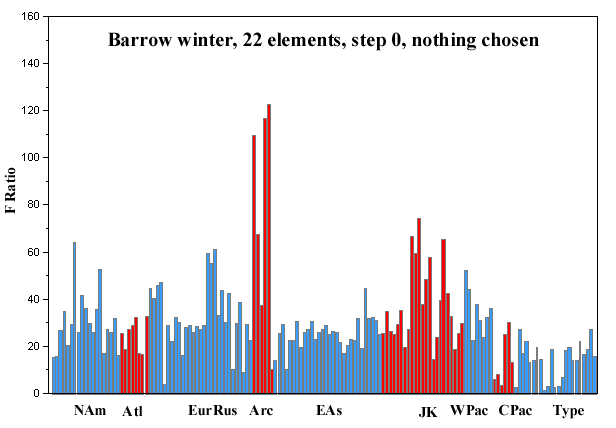
Apportionment of Barrow winter
The Barrow winter aerosol is the original example of the
now-classic "Arctic haze," the persistent smoggy condition that
settles over the entire Arctic atmosphere from November through April of each
winter. Our seven-element tracer system showed that the main source of this
aerosol was Eurasian rather than North American. Within Eurasia, the main
sources seemed to extend from Europe into Siberia. The location of these sources
was confirmed by meteorology. Now the interesting question is whether the
extended tracer system gives the same answer. We will see that it does, but not
without some bumps in the road.
One of the bumps is that the full suite of 22 elements does
not allow a satisfying fit. Dropping the number to 19 by removing the three
major marine elements Na, Mg, and Ca improves the fit considerably. Another bump
is that the fits lead to other Arctic sites (parallel receptors) rather than
genuine midlatitude sources. At least for the moment, we have to get to real
sources in two or three steps rather going directly from Barrow.
We present the apportionments for 22 and 19 elements
separately. That for 22 elements is shown directly below. The overall map of steps is shown in the table
below, with links for quick viewing. For the solutions for 19 elements, click
here.
| Barrow, Alaska, winter | |||||
|
22 elements |
19 elements |
||||
|
Arctic solution |
European solution |
Arctic solution |
North American solution |
East Asian solution |
|
| Step 0 | Nothing chosen | Nothing chosen | |||
| Step 2 | Sea and best crust (FEC) chosen, fit 8.59 | Sea and best crust (FEC) chosen, fit 7.64 | |||
| Step 3 | Norway added, fit 2.42 | Laptev added, fit 0.94 | Norway added, fit 1.18 | Akron added, fit 3.26 | Ube added, fit 2.98 |
| Step 4 | North Sea added, fit 0.71 | Bear Island added, fit 0.75 | Sudbury added, fit 2.69 | Seoul added, fit 2.49 | |
| Step 5 | TransEur added, fit 0.69 | Ny-┼lesund added, fit 0.66 | West Point Added, fit 2.34 | Oku winter added, fit 1.80 | |
| Step 6 | DCref added, fit 1.92 | ||||
The Arctic thread for 22 elements is shown in red italic below. It consists of only one place-signature, Norway, and leads to a very unsatisfactory solution.
| Barrow, Alaska, winter | |||||
|
22 elements |
19 elements |
||||
|
Arctic solution |
European solution |
Arctic solution |
North American solution |
East Asian solution |
|
| Step 0 | Nothing chosen | Nothing chosen | |||
| Step 2 | Sea and best crust (FEC) chosen, fit 8.59 | Sea and best crust (FEC) chosen, fit 7.64 | |||
| Step 3 | Norway added, fit 2.42 | Laptev added, fit 0.94 | Norway added, fit 1.18 | Akron added, fit 3.26 | Ube added, fit 2.98 |
| Step 4 | North Sea added, fit 0.71 | Bear Island added, fit 0.75 | Sudbury added, fit 2.69 | Seoul added, fit 2.49 | |
| Step 5 | TransEur added, fit 0.69 | Ny-┼lesund added, fit 0.66 | West Point Added, fit 2.34 | Oku winter added, fit 1.80 | |
| Step 6 | DCref added, fit 1.92 | ||||
Step 0, nothing chosen, appears to be encouraging, but it turns out to be short-lived. With minor exceptions for a few favorable-looking sources in North America, Eurasia, and Japan/Korea, the major sources seem to be other Arctic sites such as northern Norway, Ny-┼lesund (Spitsbergen), and the Laptev Sea. These places are not sources, of course, but other manifestations of the same aerosol seen at Barrow. The problem is to get beyond these sites and back to genuine source regions.

The picture for step 2, after sea and Far East Crust (FEC) are chosen, is different. The Arctic sites remain with the highest F-ratios, but the lowest of them are rivaled by Korea, some of the Japanese sites, and to a lesser extent European and North American locations. Thus there are three possible branches of apportionment (threads) to be investigated: Arctic sites (which are parallel receptors rather than sources), Europe and Russia (which we found earlier to be the true sources), and Japan/Korea (which seem to be eliminated meteorologically). These strands will be presented later. For now, we restrict ourselves to the Arctic sites.

Step 3 with the full 22 elements admits northern Norway, the Arctic site with the highest F-ratio. That produces a problem similar to that seen for Lin'an below, where no reasonable further sources remain, even though the fit is poor (2.42 in this case). Something is wrong with the available signatures or with the signature of Barrow itself. Since the signatures seem to work reasonably elsewhere, we suspect that the problem lies in the marine elements. We thus removed the three marine elements Na, Mg, and Ca and continued with 19.
